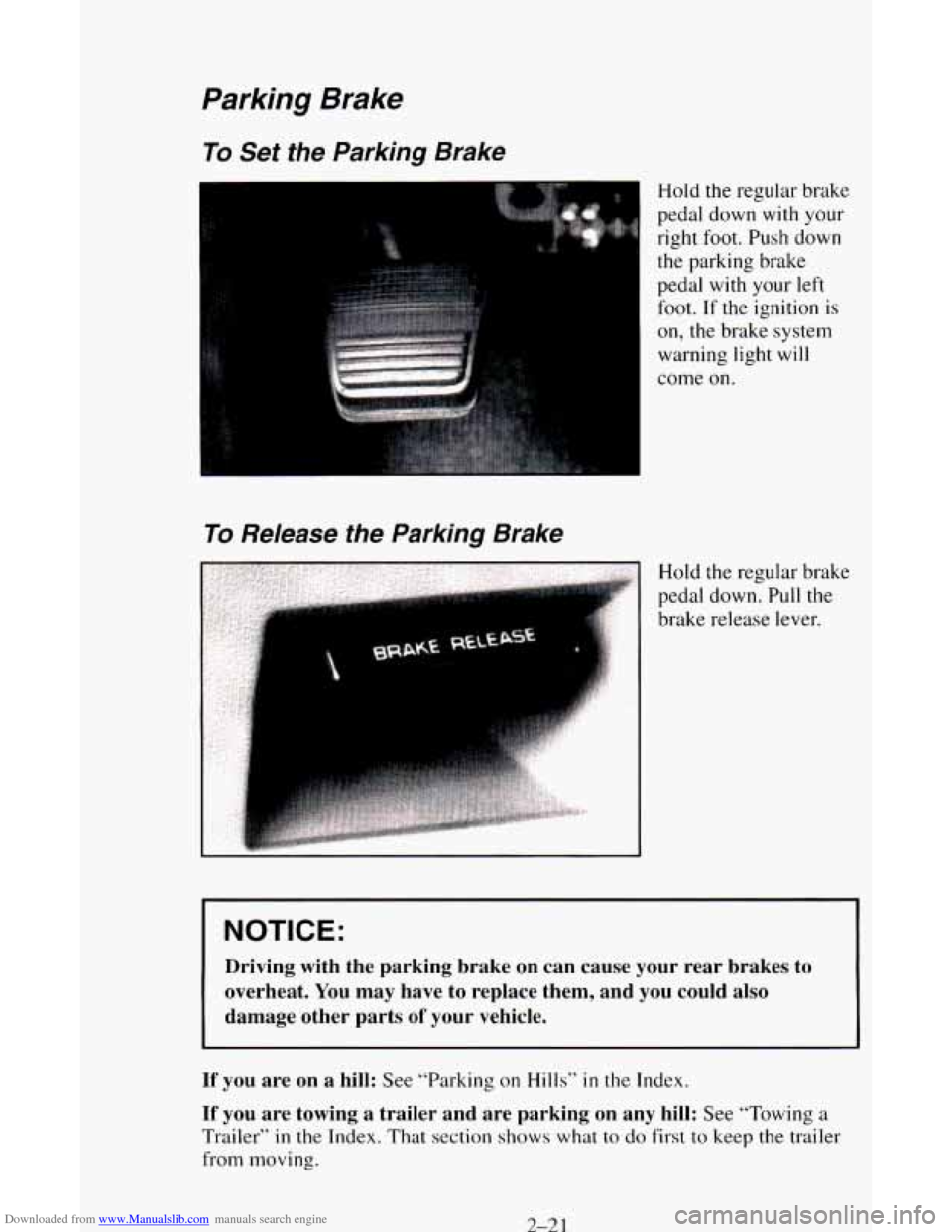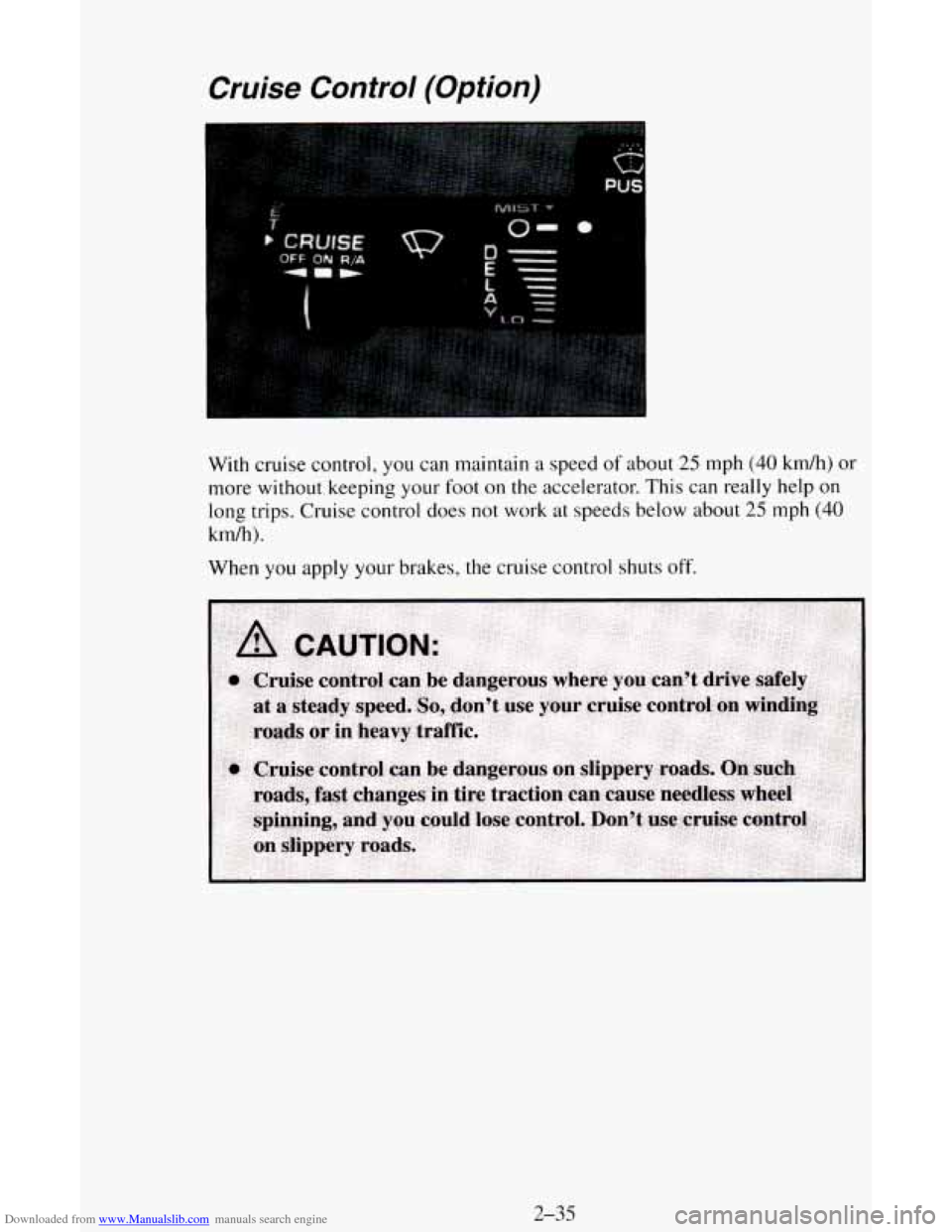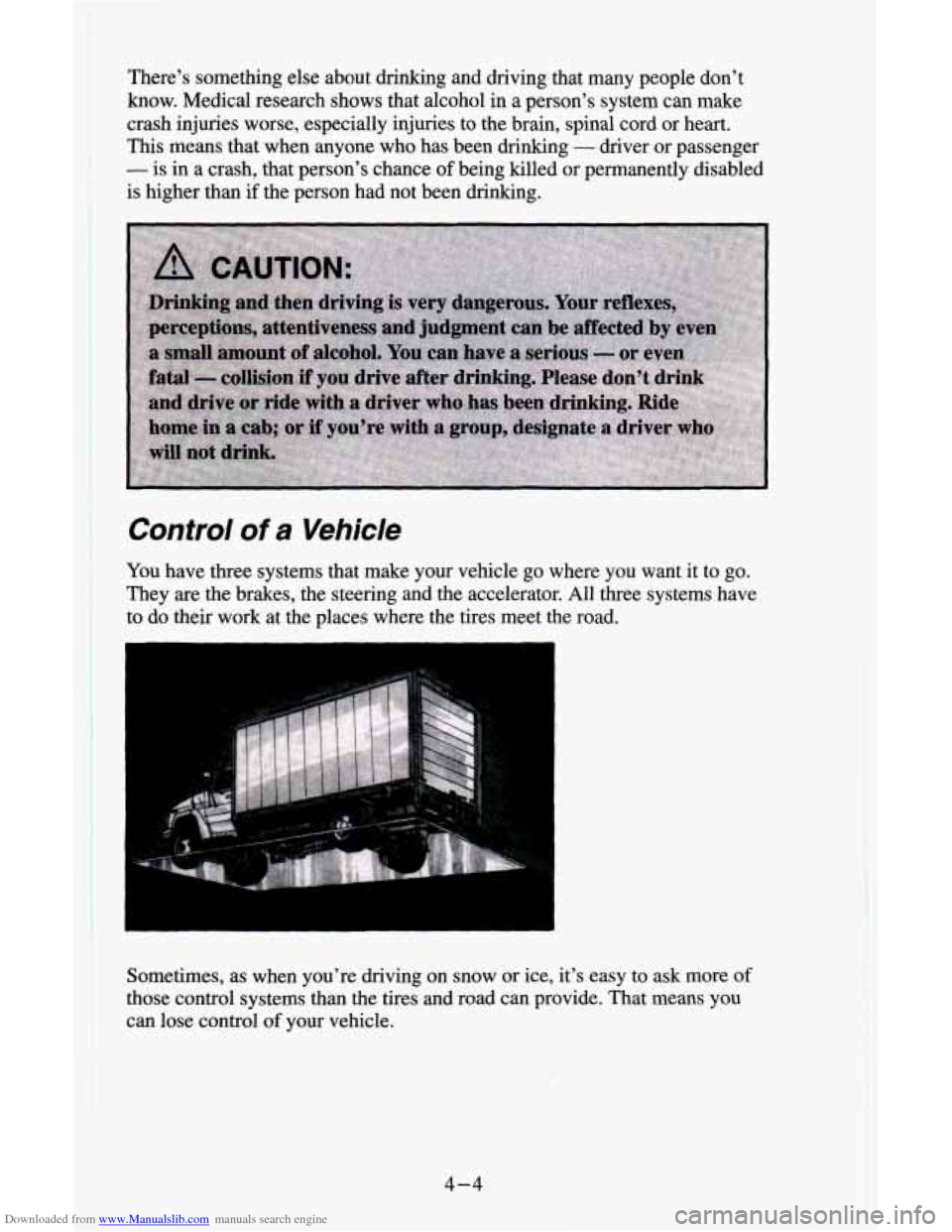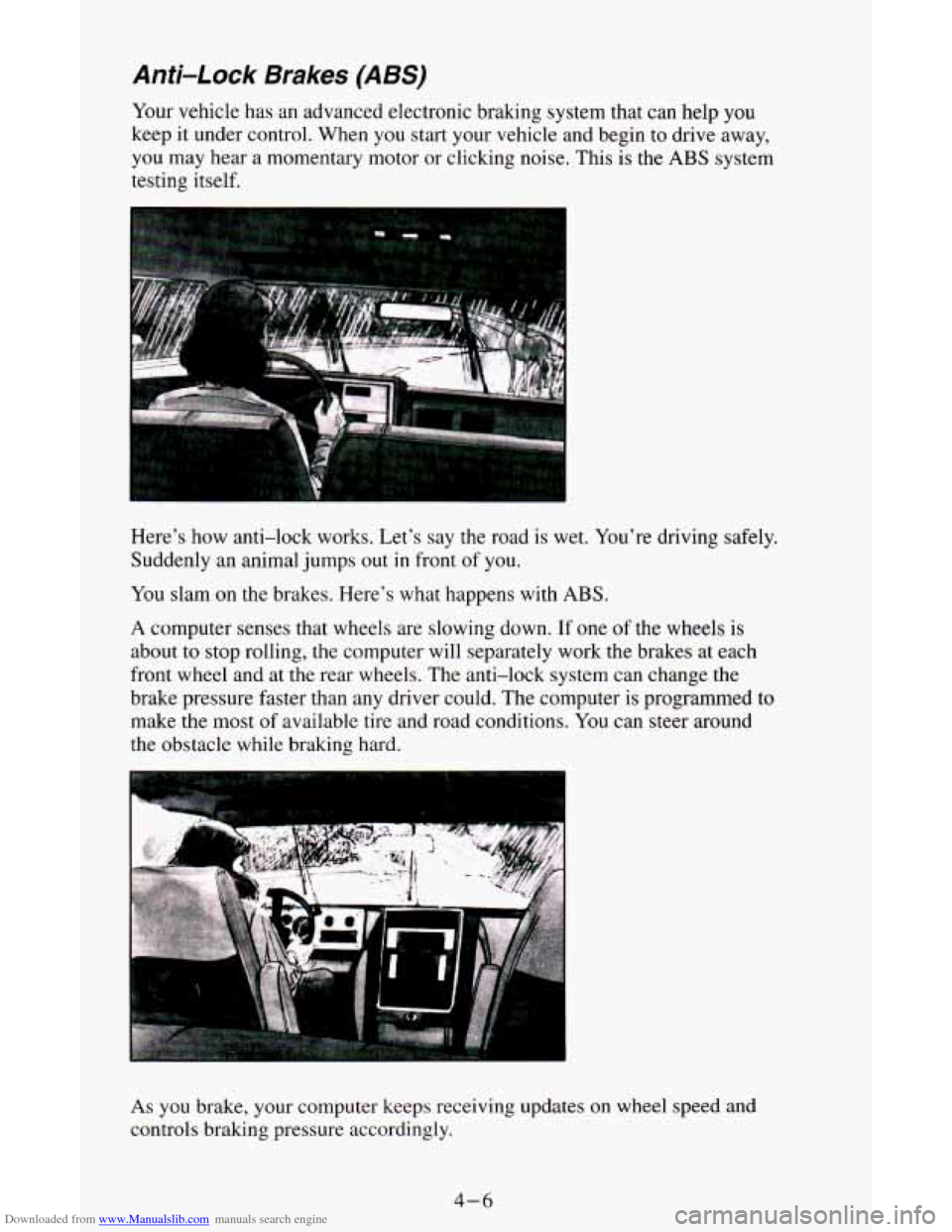1995 CHEVROLET ASTRO CARGO VAN brakes
[x] Cancel search: brakesPage 73 of 342

Downloaded from www.Manualslib.com manuals search engine Ensure the shift lever is fully in PARK (P) range before starting the engine.
Your vehicle has a brake-transmission shift interlock. You have
to fully
apply your regular brakes before you can shift from PARK
(P) when the
ignition key is in the RUN position. If you cannot
shift out of PARK (P),
ease pressure
on the shift lever - push the shift lever all the way into
PARK
(P) as you maintain brake application. Then move the shift lever into
the gear you wish. See “Shifting Out of PARK (P)” in this section.
REVERSE (R) - Use this gear to back up.
NOTICE:
Shifting to REVERSE (R) while your vehicle is moving forward
could damage your transmission. Shift to REVERSE
(R) only
after your vehicle is stopped.
To rock your vehicle back and forth to get out of snow, ice or sand
without damaging your transmission, see “If You’re Stuck: In Sand,
Mud, Ice or
Snow’’ in the Index.
NEUTRAL (N) - In this position, your engine doesn’t connect with
the wheels.
To restart when you’re already moving, use NEUTRAL (N)
only. Also, use NEUTRAL
(N) when your vehicle is being towed.
A CAUTION:
Shifting out of PARK (P) or NEUTRAL (N) while your engine is
“racing” (running at high speed) is dangerous. Unless your foot
is firmly on the brake pedal, your vehicle could move very
rapidly. You could lose control and hit people or objects. Don’t
shift out
of PARK (P) or NEUTRAL (N) while your engine is
racing.
NOTICE:
Damage to your transmission caused by shifting out of PARK
(P) or NEUTRAL (N) with the engine racing isn’t covered by
your warranty.
2- 19
Page 74 of 342

Downloaded from www.Manualslib.com manuals search engine 0
0
0
0
OVERDRIVE (0)
This position is for normal driving. If you need more power for
passing, and you’re:
- Going less than about 35 mph (56 km/h), push your accelerator
- Going about 35 mph (56 km/h) or more, push the accelerator pedal
pedal
about halfway down.
all the way down.
You’ll shift down to the next gear and have
more power.
OVERDRIVE
(0) should not be used when towing a trailer, carrying a
heavy load, or driving on steep hills. Select DRIVE (D) when operating
the vehicle under any of these conditions.
DRIVE (D) - This is like OVERDRIVE (@), but you never go into
OVERDRIVE
(0). You should use DRIVE (D) when towing a trailer,
carrying
a heavy load or driving on steep hills.
SECOND GEAR (2) - This position gives you more power but lower
fuel economy. You can use SECOND GEAR
(2) on hills. It can help
control your speed as you go down steep
mountain roads, but then you
would also want to use your brakes off and on.
If
you manually select SECOND GEAR (2), the transmission will drive
in second gear. You may use this feature for reducing torque to the rear
wheels when you are trying to start your vehicle from
a stop on
slippery road surfaces.
FIRST GEAR (1) - This position gives you even more power (but
lower fuel economy) than SECOND GEAR
(2). You can use it on very
steep hills, or
in deep snow or mud. If the selector lever is put in FIRST
GEAR
(I), the transmission won’t shift into FIRST GEAR (1) until the
vehicle is going slowly enough.
NOTICE:
If your rear wheels can’t rotate, don’t try to drive. This \
might
happen if you were stuck in very deep sand or mud or were u\
p
against a solid object. You could damage your transmission
or
transfer case or both.
Also, if you stop when going uphill, don’t hold your vehicle ther\
e
with only the accelerator pedal. This could overheat and damage\
the transmission.
Use your brakes or shift into PARK (P) to hold
your vehicle in position on a hill.
2-20
Page 75 of 342

Downloaded from www.Manualslib.com manuals search engine Parking Brake
To Set the Parking Brake
Hold the regular brake
To Release the Parking Brake
pedal down with your
right foot. Push down
the parking brake
pedal with your left
foot.
If the ignition is
on, the brake system
warning light
will
come on.
Hold the regular brake
pedal down. Pull the
brake release lever.
NOTICE:
Driving with the parking brake on can cause your rear brakes to
overheat. You may have to replace them, and you could also
damage other parts
of your vehicle.
If you are on a hill: See “Parking on Hills” in the Index.
If you are towing a trailer and are parking on any hill: See “Towing a
Trailer” in the Index. That section shows what to do first to keep the trailer
from moving.
2-21
Page 89 of 342

Downloaded from www.Manualslib.com manuals search engine Cruise Control (Option)
I
With cruise control, you can maintain a speed of about 25 mph (40 km/h) or
more without keeping your foot
on the accelerator. This can really help on
long trips. Cruise control does not work at speeds below about
25 mph (40
km/h).
When you apply your brakes, the cruise control shuts off.
2-35
Page 109 of 342

Downloaded from www.Manualslib.com manuals search engine If the light stays on, or comes on when you’re driving, your vehicle needs
service.
If the regular brake system warning light isn’t on, you still have
brakes, but you don’t have anti-lock brakes. If the regular brake system
warning light
is also on, you don’t have anti-lock brakes and there’s a
problem with your regular brakes. See “Brake System Warning Light”
earlier in this part.
Malfunction Indicator Lamp
(SERVICE ENGINE
SOON)
The amber
Malfunction Indicator
(SERVICE
ENGINE
SOON) Lamp is
located on the
passenger side of your
standard cluster. If
you have the digital
cluster, it is
on the
driver’s side.
A computer monitors operation of your fuel, ignition and emission control
systems. This light should come on when the ignition is
on, but the engine is
not running, as a check to show you it is working.
If it does not come on at
all, have it fixed right away.
If it stays on, or it comes on while you are
driving, the computer is indicating that you have a problem. You should
take your vehicle in for service soon.
NOTICE:
If you keep driving your vehicle with this light on, after a whi\
le
the emission controls won’t work as well, your fuel economy \
won’t be as good and your engine may not run as smoothly. \
This
could lead to costly repairs not covered by your warranty.
Indicator Lights
Indicator lights go on when you use your turn signals, change from low
beam headlamps to high beams, or when you use your hazard flashers.
The
next few pages will also tell you about the indicator lights on your vehicle
and help you locate them.
2-55
Page 142 of 342

Downloaded from www.Manualslib.com manuals search engine There’s something else about drinking and driving that many people don’t
know. Medical research shows that alcohol in
a person’s system can make
crash injuries worse, especially injuries to
the brain, spinal cord or heart.
This means that when anyone who has been drinking - driver or passenger
- is in a crash, that person’s chance of being killed or permanently disabled
is higher than if the person had not been drinking.
Control of a Vehicle
You have three systems that make your vehicle go where you want it to go.
They
are the brakes, the steering and the accelerator. All three systems have
to do their work at the places where the tires meet the road.
Sometimes, as when you’re driving
on snow or ice, it’s easy to ask more of
those control systems than the tires and road can provide. That means you
can lose control of your vehicle.
4-4
Page 143 of 342

Downloaded from www.Manualslib.com manuals search engine Braking
Braking action involves perception time and reaction time.
First, you have to decide to push on the brake pedal. That’s perception time.
Then you have to bring up your foot and do it. That’s reaction time.
Average reaction time is about 3/4 of a second. But that’s only an average. It
might be less with one driver and as long as two or three seconds or more
with another. Age, physical condition, alertness, coordination, and eyesight all play a part.
So do alcohol, drugs and frustration. But even in 3/4 of a
second, a vehicle moving at
60 mph (100 km/h) travels 66 feet (20 m). That
could be a lot of distance in an emergency,
so keeping enough space
between your vehicle and others is important.
And, of course, actual stopping distances vary greatly with the surface of the
road (whether it’s pavement or gravel); the condition of the road (wet, dry,
icy); tire tread; and the condition of your brakes.
Avoid needless heavy braking. Some people drive in spurts
- heavy
acceleration followed by heavy braking
- rather than keeping pace with
traffic. This is a mistake. Your brakes may not have time to cool between
hard stops. Your brakes will wear out much faster if you do a lot
of heavy
braking. If you keep pace with the traffic and allow realistic following
distances, you will eliminate a lot of unnecessary braking. That means better
braking and longer brake
life.
If your engine ever stops while you’re driving, brake normally but don’t
pump your brakes. If you do, the pedal may get harder to push down. If
your engine stops, you will still have some power brake assist. But you will
use it when you brake. Once the power assist is used up, it may take longer
to stop and the brake pedal will be harder to push.
4-5
Page 144 of 342

Downloaded from www.Manualslib.com manuals search engine Anti-Lock Brakes (ABS)
Your vehicle has an advanced electronic braking system that can help you
keep it under control. When you start your vehicle and begin to drive away,
you may hear a momentary motor or clicking noise. This is the ABS system
testing itself.
nere
s now anti-lock works. Let’s say the road is wet. You’re driving safely.
Suddenly an animal jumps out
in front of you.
You slam on the brakes. Here’s what happens with ABS.
A computer senses that wheels are slowing down. If one of the wheels is
about
to stop rolling, the computer will separately work the brakes at each
front wheel and at
the rear wheels. The anti-lock system can change the
brake pressure faster than any driver could. The computer is programmed to
make the most
of available tire and road conditions. You can steer around
the obstacle while braking hard.
As you brake, your computer keeps receiving updates on wheel speed and
controls braking pressure accordingly.
4-6